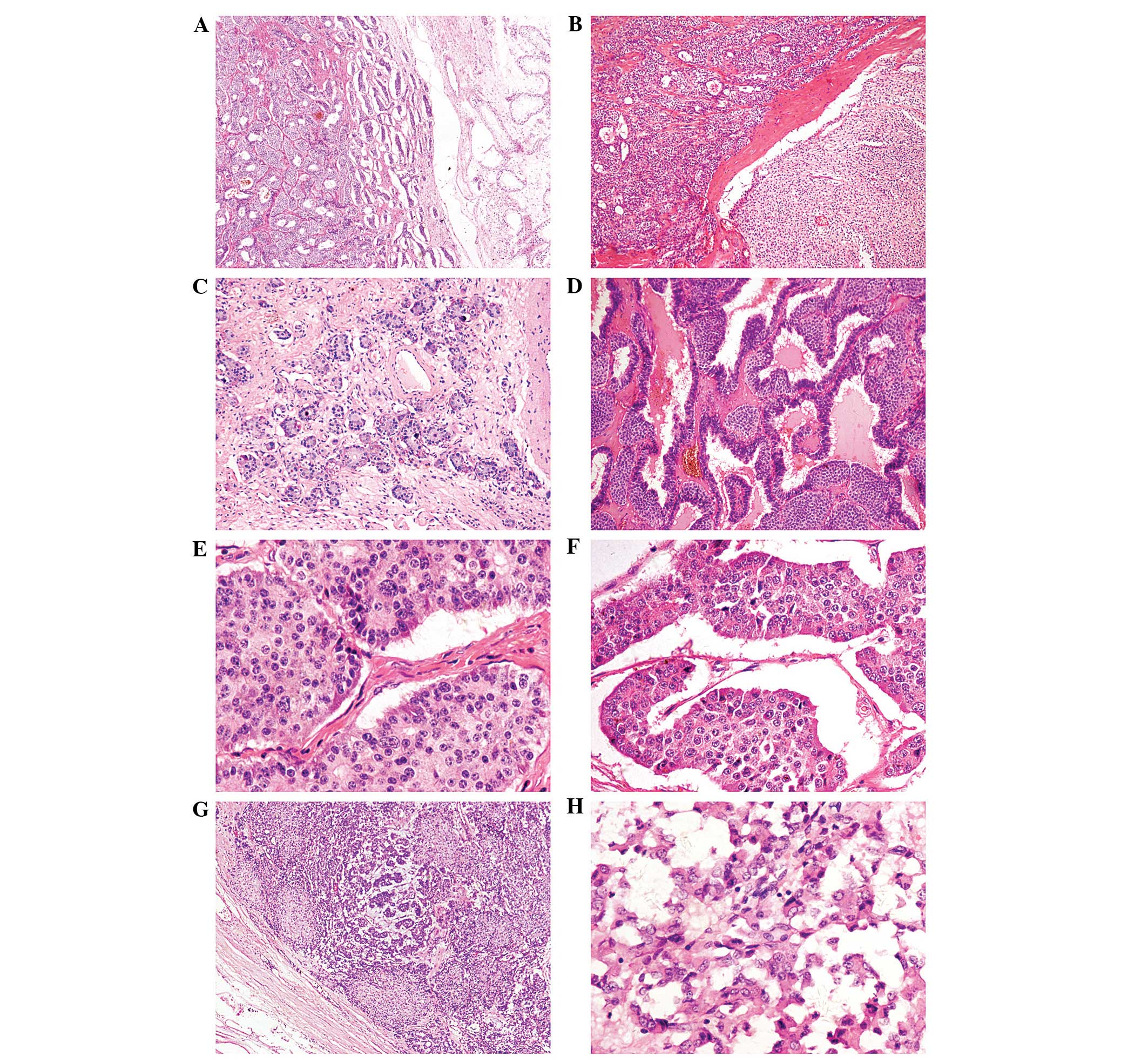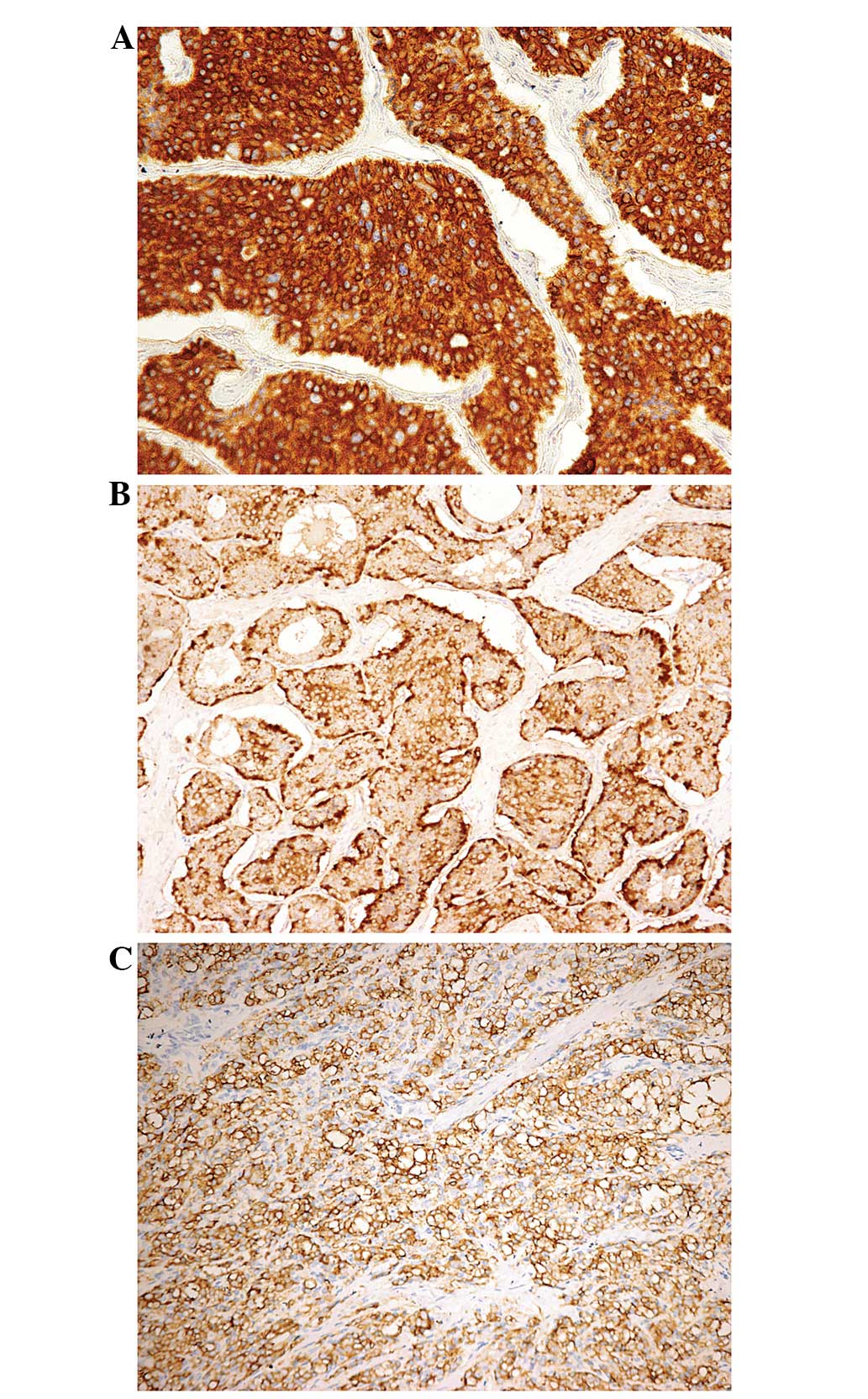|
1
|
Stroosma OB and Delaere KP: Carcinoid
tumours of the testis. BJU Int. 101:1101–1105. 2008. View Article : Google Scholar : PubMed/NCBI
|
|
2
|
Modlin IM, Lye KD and Kidd M: A 5-decade
analysis of 13,715 carcinoid tumors. Cancer. 97:934–959. 2003.
View Article : Google Scholar : PubMed/NCBI
|
|
3
|
Hayashi T, Iida S, Taguchi J, et al:
Primary carcinoid of the testis associated with carcinoid syndrome.
Int J Urol. 8:522–524. 2001. View Article : Google Scholar : PubMed/NCBI
|
|
4
|
Simon HB, McDonald JR and Culp OS:
Argentaffin tumor (carcinoid) occurring in a benign cystic teratoma
of the testicle. J Urol. 72:892–894. 1954.PubMed/NCBI
|
|
5
|
Wolf M, Wunderlich H, Hindermann W, et al:
Primary carcinoid tumor of the testicle without metastases in
combination with testicular atrophy and testosterone deficiency.
Int Urol Nephrol. 38:625–628. 2006. View Article : Google Scholar : PubMed/NCBI
|
|
6
|
Kato N, Motoyama T, Kameda N, et al:
Primary carcinoid tumor of the testis: Immunohistochemical,
ultrastructural and FISH analysis with review of the literature.
Pathol Int. 53:680–685. 2003. View Article : Google Scholar : PubMed/NCBI
|
|
7
|
Reyes A, Moran CA, Suster S, et al:
Neuroendocrine carcinomas (carcinoid tumor) of the testis. A
clinicopathologic and immunohistochemical study of ten cases. Am J
Clin Pathol. 120:182–187. 2003. View Article : Google Scholar : PubMed/NCBI
|
|
8
|
Wang WP, Guo C, Berney DM, et al: Primary
carcinoid tumors of the testis: a clinicopathologic study of 29
cases. Am J Surg Pathol. 34:519–524. 2010. View Article : Google Scholar : PubMed/NCBI
|
|
9
|
Ulbright TM and Young RH: Carcinoid tumor
of the testis. Am J Clin Pathol. 121:297–298. 2004.PubMed/NCBI
|
|
10
|
Talerman A, Gratama S, Miranda S, et al:
Primary carcinoid tumor of the testis: case report, ultrastructure
and review of the literature. Cancer. 42:2696–2706. 1978.
View Article : Google Scholar : PubMed/NCBI
|
|
11
|
Neely D and Gray S: Primary carcinoid
tumour of the testis. Ulster Med J. 80:79–81. 2011.PubMed/NCBI
|
|
12
|
Kim HJ, Cho MY, Park YN, et al: Primary
carcinoid tumor of the testis: immunohistochemical, ultrastructural
and DNA flow cytometric study of two cases. J Korean Med Sci.
14:57–62. 1999. View Article : Google Scholar : PubMed/NCBI
|
|
13
|
Oberg K, Akerstrom G, Rindi G, et al:
Neuroendocrine gastroenteropancreatic tumours: ESMO clinical
practice guidelines for diagnosis, treatment and follow-up. Ann
Oncol 21 Suppl. 5:v223–v227. 2010. View Article : Google Scholar
|
|
14
|
Son HY, Ra SW, Jeong JO, et al: Primary
carcinoid tumor of the bilateral testis associated with carcinoid
syndrome. Int J Urol. 11:1041–1043. 2004. View Article : Google Scholar : PubMed/NCBI
|
|
15
|
Kaufman JJ and Waisman J: Primary
carcinoid tumor of testis with metastasis. Urology. 25:534–536.
1985. View Article : Google Scholar : PubMed/NCBI
|
|
16
|
Thomas JC and Jones JS: Primary carcinoid
tumor of the testis found at the time of elective sterilization. J
Androl. 25:338–339. 2004.PubMed/NCBI
|
|
17
|
Zavala-Pompa A, Ro JY, el-Naggar A, et al:
Primary carcinoid tumor of testis. Immunohistochemical,
ultrastructural and DNA flow cytometric study of three cases with a
review of the literature. Cancer. 72:1726–1732. 1993. View Article : Google Scholar : PubMed/NCBI
|
|
18
|
Fucs M, Romero FR, de Castewm Germanos, et
al: Testicular metastasis 10 years after resection of appendiceal
carcinoid. Urology. 65:5912005. View Article : Google Scholar : PubMed/NCBI
|
|
19
|
Lin X, Saad RS, Luckasevic TM, et al:
Diagnostic value of CDX-2 and TTF-1 expressions in separating
metastatic neuroendocrine neoplasms of unknown origin. Appl
Immunohistochem Mol Morphol. 15:407–414. 2007. View Article : Google Scholar : PubMed/NCBI
|
|
20
|
Chan ES, Alexander J, Swanson PE, et al:
PDX-1, CDX-2, TTF-1 and CK7: a reliable immunohistochemical panel
for pancreatic neuroendocrine neoplasms. Am J Surg Pathol.
36:737–743. 2012. View Article : Google Scholar : PubMed/NCBI
|
|
21
|
McCluggage WG, Kennedy K and Busam KJ: An
immunohistochemical study of cervical neuroendocrine carcinomas:
Neoplasms that are commonly TTF1 positive and which may express
CK20 and P63. Am J Surg Pathol. 34:525–532. 2010. View Article : Google Scholar : PubMed/NCBI
|
|
22
|
Hodzic J, Golka K and Schulze H: Primary
testicular carcinoid. Med Sci Monit. 10:CS46–CS48. 2004.PubMed/NCBI
|
|
23
|
Modlin IM, Latich I, Kidd M, et al:
Therapeutic options for gastrointestinal carcinoids. Clin
Gastroenterol Hepatol. 4:526–547. 2006. View Article : Google Scholar : PubMed/NCBI
|
|
24
|
Kaiser ED, See RF, Rechdouni AK, et al:
Uveal metastasis 43 years after resection of bronchogenic
carcinoid. Br J Ophthalmol. 86:1191–1192. 2002. View Article : Google Scholar : PubMed/NCBI
|
|
25
|
Sutherland RS, Wettlaufer JN and Miller
GJ: Primary carcinoid tumor of the testicle: a case report and
management schema. J Urol. 148:880–882. 1992.PubMed/NCBI
|
















